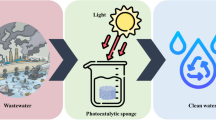Abstract
In this work, dithiocarbamate (-NH-CS2)-functionalized dendritic fibrous nanosilica (KCC-1) with significant adsorbtion capacity was effectively synthesized using the reliable reaction process. Field emission scanning electron microscopy, FT-IR and transmission electron microscopy were used to analyze particle size and morphology of nanoadsorbent. Additionally, the functionalization of bare materials (dendritic fibrous nanosilica) with dithiocarbamate was confirmed with FT-IR and energy-dispersive X-ray spectroscopy. Furthermore, nitrogen adsorption/desorption analysis (BET equation) was utilized to evaluate KCC-1-NH-CS2 porosity (surface are, pore size, pore volume). The UV–Vis spectrophotometric method was used to evaluate organic dye removal from aqueous solutions. It was found that dithiocarbamate-functionalized KCC-1-NH2 with narrow size distribution, high surface area (133 m2/g) and effortlessly available pores had good potential for highly efficient removal of malachite green (MG) from contaminated waters. Electrostatic interactions between the negatively charged dithiocarbamate group (NH-CS2−) of nanoadsorbent and cationic MG in KCC-1-NH-CS2 channels provided a rapid (45 min) removal of this organic contaminated agent from waste water with adsorbtion capacity higher than 98%. Finally, an efficient nanoadsorbent was introduced to remove organic dyes from wastewaters and industrial purification.









Similar content being viewed by others
References
Bayal N, Singh B, Singh R, Polshettiwar V (2016) Size and fiber density controlled synthesis of fibrous nanosilica spheres (KCC-1). Sci. Rep. 6:24888
Daneshvar N, Ayazloo M, Khataee AR, Pourhassan M (2007) Biological decolorization of dye solution containing Malachite Green by microalgae Cosmarium sp. Bioresour Technol 98:1176–1182
Dinari M, Soltani R, Mohammadnezhad G (2017) Kinetics and thermodynamic study on novel modified-mesoporous silica MCM-41/polymer matrix nanocomposites: effective adsorbents for trace Cr(VI) removal. J Chem Eng Data 62:2316–2329
Doke SM, Yadav GD (2014) Novelties of combustion synthesized titania ultrafiltration membranein efficient removal of methylene blue dye from aqueous effluent. Chemosphere 117:760–765
Guenfoud F, Mokhtari M, Akrout H (2014) Electrochemical degradation of malachite green with BDD electrodes: effect of electrochemical parameters. Diam Relat Mater 46:8–14
Hosseinzadeh H, Abdi K (2017) Efficient removal of methylene blue using a hybrid organic-inorganic hydrogel nanocomposite adsorbent based on sodium alginate-silicone dioxide. J Inorg Organomet Polym Mater 27:1595–1612
Kaith BS, Jindal R, Sharma R (2015) Synthesis of a Gum rosin alcohol-poly (acrylamide)based adsorbent and its application in removal of malachite green dye from waste water. RSC Adv 5:43092–43104
Kusvuran E, Gulnaz O, Samil A, Yildirim Ö (2011) Decolorization of malachite green, decolorization kinetics and stoichiometry of ozone-malachite green and removal of antibacterial activity with ozonation processes. J Hazard Mater 186:133–143
Lu T, Xiang T, Huang XL, Li C, Zhao WF, Zhang Q, Zhao CS (2015) Post crosslinking towards stimuli-responsive sodium alginate beads for the removal of dyeand heavy metals. Carbohydr Polym 133:587–595
Polshettiwar V, Cha D, Zhang X, Basset JM (2010) High-surface-area silica nanospheres (KCC-1) with a fibrous morphology. Angew Chem Int Ed 49:9652–9656
Roosta M, Ghaedi M, Shokri N, Daneshfar A, Sahraei R, Asghari A (2014) Optimization of the combined ultrasonic assisted/adsorbtion method for the removal of malachite green by gold nanoparticles loaded on activated carbon: experimental design. Spectrochim Acta, Part A 118:55–65
Sadeghzadeh SM (2016) A heteropolyacid-based ionic liquid immobilized onto magnetic fibrous nano-silica as robust and recyclable heterogeneous catalysts for the synthesis of tetrahydrodipyrazolopyridines in water. RSC Adv 6:75973–75980
Sajab MS, Chia CH, Chan CH, Zakaria S, Kaco H, Chook SW, Chin SX, Noor AAM (2016) Bifunctional graphene oxide-cellulose nanofibril aerogel loaded with Fe(III) for the removal of cationic dye via simultaneous adsorbtion and Fenton oxidation. RSC Adv 6:19819–19825
Soleymani J, Hasanzadeh M, Somi MH, Shadjou N, Jouyban A (2019) Highly sensitive and specific cytosensing of HT 29 colorectal cancer cells using folic acid functionalized-KCC-1 nanoparticles. Biosens Bioelectron 132:122–131
Soltani R, Dinari M, Mohammadnezhad G (2018) Ultrasonic-assisted synthesis of novel nanocomposite of poly (vinyl alcohol) and amino-modified MCM-41: a green adsorbent for Cd (II) removal. Ultrason Sonochem 40:533–542
Stammati A, Nebbia C, De Angelis I, Albo AG, Carletti M, Rebecchi C, Zampaglioni F, Dacasto M (2005) Effects of malachite green (MG) and its major metabolite, leucomalachite green (LMG), in two human cell lines. Toxicol In Vitro 19:853–858
Tsai WT, Chen HR (2010) Removal of malachite green from aqueous solution using low-cost chlorella-based biomass. J Hazard Mater 175:844–849
Wu H, Yang R, Li R, Long C, Yang H, Li A (2015) Modeling and optimization of the flocculationprocesses for removal of cationic and anionic dyes from water by an amphoteric grafting chitosanbased flocculants using response surface methodology. Environ Sci Pollut Res Int 22:13038–13048
Zhuang Y, Yu F, Chen H, Zheng J, Ma J, Chen J (2016) Alginate/graphene double network nanocomposite hydrogel beads with low-swelling, enhanced mechanical properties, and enhanced adsorbtion capacity. J Mater Chem A 4:0885–10892
Acknowledgment
We gratefully acknowledge the support of this work by Urmia University.
Author information
Authors and Affiliations
Corresponding author
Ethics declarations
Conflict of interest
The authors declare that they have no conflict of interest.
Additional information
Editorial responsibility: Hari Pant.
Electronic supplementary material
Below is the link to the electronic supplementary material.
Rights and permissions
About this article
Cite this article
Anvari, M., Shadjou, N. Dendritic fibrous nanosilica functionalized by dithiocarbamate as a highly efficient adsorbent for the removal of malachite green from waste water based on electrostatic interaction. Int. J. Environ. Sci. Technol. 18, 1089–1096 (2021). https://doi.org/10.1007/s13762-020-02911-w
Received:
Revised:
Accepted:
Published:
Issue Date:
DOI: https://doi.org/10.1007/s13762-020-02911-w




